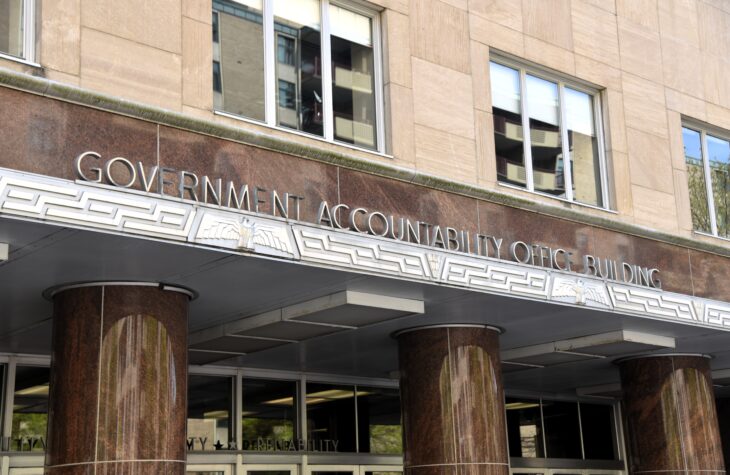
Primer: Accountability for the Government’s Accountability Office

The Constitution does not tolerate hybrid officers cloaked in legislative legitimacy yet wielding executive power. The Government Accountability Office—an entity squarely within Congress, led by a comptroller general removable only by Congress—cannot constitutionally interpret laws, direct executive behavior, or initiate litigation against the executive branch.
The Government Accountability Office (GAO) presents a growing constitutional crisis: an Article I legislative agency asserting de facto executive authority without presidential oversight or accountability. Although originally designed as a nonpartisan auditing arm to assist Congress in its legislative function, the GAO has evolved into a quasi-enforcement body that claims the power to interpret statutes, compel executive compliance, and initiate legal action under the Impoundment Control Act of 1974 (ICA). This evolution is constitutionally unsustainable. Under binding Supreme Court precedent, particularly Bowsher v. Synar and Seila Law, such functions may not be vested in an officer of the legislative branch who is insulated from presidential removal. To permit the GAO’s current role to continue is to violate both the Executive Vesting Clause and the Take Care Clause of Article II, dismantling the structural separation that secures liberty under our constitutional design.
This primer argues that the GAO’s asserted authority to interpret and enforce federal law is both doctrinally invalid and normatively corrosive—blurring the line between legislative oversight and executive execution and eroding the president’s exclusive constitutional duty to “take Care that the Laws be faithfully executed.” The GAO has no lawful role in commanding the executive. Any claim to the contrary jeopardizes the very framework of separated powers that the Framers built to guard against tyranny.
The Constitutional Structure of the GAO
The GAO was established by the Budget and Accounting Act of 1921 to replace the Treasury Department’s auditing functions with a legislative watchdog.1 In FY 2026, the GAO has requested a budget of $933.9 million, a 15 percent increase from FY 2025 levels, and supports a staff of over 3,500.2 Congress placed the agency squarely within the legislative branch under Article I, tasking it with evaluating how federal funds are spent and ensuring statutory compliance.3 These duties of the GAO fall squarely within Congress’s Article I oversight authority, supported by its power to investigate and gather information in aid of legislation.4 But the GAO’s role must end where the executive’s Article II responsibilities begin. When the agency initiates enforcement actions—seeking judicial relief or compelling executive compliance—it transgresses this constitutional boundary. Congress may inform, investigate, and advise, but it may not empower its agents to compel execution of the law; the GAO cannot legally implement or enforce federal statutes because its powers are to inform only and not coerce.
The act also created the comptroller general of the United States as the GAO’s head, a position explicitly defined in statute as legislative—not executive.5 The comptroller general is appointed by the president from a list of candidates submitted by a bipartisan congressional commission and confirmed by the Senate.6 Statutorily, removal is only possible through impeachment or joint resolution by Congress.7
In Bowsher v. Synar, the Supreme Court held that this structure renders the comptroller a legislative officer and thus ineligible to exercise executive functions such as executing budgetary cuts under the Gramm–Rudman–Hollings Act.8 The Court saw that because the comptroller general was a legislative officer under Congress’s removal authority, entrusting him with executive functions violated the separation of powers and the Take Care Clause of Article II.9 This precedent is directly applicable to the GAO’s current role under the ICA. By empowering the comptroller general to interpret, enforce, and potentially sue to compel execution of federal spending laws, the ICA impermissibly vests executive power in a legislative officer. As the Court made clear, “Congress cannot reserve for itself the power of removal of an officer charged with the execution of the laws except by impeachment,”10 and doing so transforms the comptroller general into an unconstitutional hybrid actor: “Congress cannot reserve for itself the power of removal of an officer charged with the execution of the laws.”11 Similarly, in Buckley v. Valeo, the Court emphasized that “Officers of the United States” who exercise “significant authority pursuant to the laws of the United States” must be appointed consistent with Article I.12 Congress may not circumvent the Appointments Clause by installing legislative agents into executive functions.13 The GAO’s issuance of legal opinions purporting to compel executive action runs afoul of these precedents.
The GAO’s Politicization and Structural Illegitimacy
The doctrinal backdrop above renders the GAO’s legal determinations constitutionally nonbinding. Any suggestion to the contrary improperly empowers a legislative agency with quasi-executive authority. As Justice Antonin Scalia observed, “Without a secure structure of separated powers, our Bill of Rights would be worthless.”14 Yet the GAO continues to prove itself to be a partisan agency that disrupts this delicate balance.
The Comptroller General has ruled that the president improperly impounded funds four different times this year,15 and the GAO to date has more than forty-six separate investigations into whether the current Trump administration allegedly withheld congressionally appropriated funds.16 The agency has also publicly signaled that it is considering issuing legal options to sue the president under 2 U.S.C. § 687 or direct Congress to compel the executive branch to release funds.17 Congressional action, however, is limited to holding oversight hearings, issuing subpoenas, and using public pressure to compel the administration to comply. Congress cannot enforce subpoenas unilaterally; it must refer noncompliance to the Department of Justice (DOJ) for criminal contempt under 2 U.S.C. § 192, pursue a civil enforcement action under 2 U.S.C. §§ 288b–288d, or invoke its rare contempt authority—an internal process that includes detention by the sergeant at arms. Even Congress must rely on the executive branch (DOJ) to compel compliance, a requirement that underscores the fact that enforcement, by nature, belongs to Article II. As Jeff Clark has observed, the Department of Justice is not an “independent” entity, but rather part of the executive branch under the President’s constitutional control.18 Allowing a legislative officer to sue the executive is a constitutional anomaly: It effectively makes the legislature prosecutor, judge, and enforcer, contrary to Articles I and II.19
In response to those who argue that GAO enforcement is justified because it ensures fidelity to congressional appropriations, the Constitution rejects such utilitarian reasoning. As the Court made clear in Clinton v. City of New York, the structural limits imposed by the Constitution cannot be waived for efficiency.20 Allowing Congress to enforce its own statutes through a legislative officer—even in the name of fiscal discipline—obliterates the separation of powers. Scalia rightly warned against such one-way empowerment.21
GAO’s recent treatment of pocket rescissions is another example of its partisan posture against the President. For over forty years, GAO’s own precedent recognized that the ICA permits the President to transmit a rescission proposal at any point, even late in the fiscal year, withhold funds for the 45-day consideration period, and allow them to lapse before Congress acts. In 1975, GAO acknowledged this reality, labeling it a “major deficiency” in the ICA and urging Congress to amend the statute—but conceding that, under the law as written, such lapses could occur.22 Congress never adopted GAO’s recommendation, leaving the ICA’s text unchanged for decades. Only now during the Trump Administration did GAO abruptly reverse course, issuing new guidance declaring pocket rescissions “not permitted” and implying they are unconstitutional.23 GAO’s sudden change after decades of acquiescence underscores that it is no neutral arbiter, but a legislative branch office willing to bend its interpretations to frustrate this President’s lawful use of authority under the ICA.
The D.C. Circuit’s decision in Global Health Council v. Trump underscores why the GAO’s position lacks any binding effect.24 The court reaffirmed that the judiciary itself may not enjoin the President’s exercise of discretionary statutory authority, nor can the APA be used to compel or restrain the President directly.25 If Article III courts lack such power, the GAO as an advisory entity of the legislative branch with no enforcement authority certainly cannot dictate to the president how to exercise rescission authority that Congress has left intact since the 1970s. The GAO’s pronouncement on pocket rescissions is therefore not law, but partisan commentary dressed up as legalese.
The Trump White House has rightly declined to cooperate with several of the GAO’s demands and has justly accused the agency of partisanship, overreach, and double standards—particularly in light of the GAO’s divergent rulings on the Ukraine funding pause versus the Biden administration’s border wall impoundment.26 In both cases, the executive delayed the allocation of funds pending policy review; the GAO found Trump in violation of the ICA while exonerating Biden—an inconsistency that undermines the agency’s claims to nonpartisan neutrality. These divergent conclusions sparked criticism from Republicans in the House of Representatives who accused the GAO of applying “two sets of rules” to similar acts of executive impoundment.27
The GAO’s legal conclusions are entitled to no binding force under the Constitution. And the White House has no legal obligation to abide by or give any attention to the congressional watchdog’s “advisory notice.” The agency’s structural insulation from executive oversight and its apparent political double standards render it an unreliable source of impartial legal interpretation. Under Bowsher, Buckley, and Seila Law, no legislative officer can constitutionally wield executive authority. The GAO must therefore return to its proper role: providing nonbinding fiscal analysis, not enforcing or interpreting the law.
The Comptroller General as an Executive Officer
Should the comptroller general of the United States exercise executive power—enforcing laws, issuing binding legal opinions on executive conduct, and initiating litigation to compel executive compliance—then, under settled constitutional doctrine, the president must have removal authority over him; Article II of the Constitution vests the executive power in the president.28 The Supreme Court has long held that this power entails the ability to remove executive officers who wield Article II functions.29 In Myers, the Court struck down restrictions on the president’s ability to remove a postmaster, emphasizing that “[t]he vesting of the executive power in the President was essentially a grant of the power to execute the laws” and that “the power of removal is incident to the power of appointment” when execution of law is involved.30 In Seila Law, the Court saw that a principal officer wielding significant executive power must be removable by the president.31
Even more directly, in Bowsher, the Court held that the comptroller general is a legislative officer because he is removable only by Congress via joint resolution or impeachment.32 But the comptroller is acting not as a legislative advisor but as an executive officer. And under the logic of Myers and Seila Law, such an officer must be subject to removal by the president. To deny the president this removal power while simultaneously allowing the comptroller general to exercise executive authority violates the separation of powers and turns the Take Care Clause into a “congressional leash.”
The contradiction is untenable. Either the comptroller general is a legislative officer and cannot execute the laws or he executes the laws and must be removable by the president. Congress cannot have it both ways without violating the Constitution.
Conclusion
The Constitution does not tolerate hybrid officers cloaked in legislative legitimacy yet wielding executive power. The Government Accountability Office—an entity squarely within Congress, led by a comptroller general removable only by Congress—cannot constitutionally interpret laws, direct executive behavior, or initiate litigation against the executive branch. These are Article II functions, not privileges of legislative convenience. As the Supreme Court held in Bowsher v. Synar, when Congress reserves the power to remove an officer, it forfeits the right to assign that officer executive duties. Seila Law reinforces this structural boundary: The power to enforce the law must remain under presidential control, and those who exercise it must be subject to presidential removal.
The GAO’s current trajectory flouts these principles. Its aggressive posture under the Impoundment Control Act transforms it from an auditor into an enforcer—something the Constitution never authorized and the Framers never imagined. Worse still, by cloaking partisan judgments in the garb of “legal findings,” the GAO threatens both institutional legitimacy and the integrity of the separation of powers. A legislative agency cannot serve as prosecutor, judge, and executioner of the law.
If the comptroller general may sue the president, compel agency conduct, or bind executive interpretation by fiat, then the unitary executive is a “parchment promise.” The ICA must be repealed or rewritten. Anything less invites a constitutional inversion, one in which the legislative branch not only writes the laws but ensures their execution through its own agents. That is not oversight but usurpation. To restore the separation of powers, the GAO must return to its proper constitutional footing: an advisor with a sharp pen, not a sword.
Endnotes
1. Budget and Accounting Act of 1921, ch. 18, § 301, 42 Stat. 20, 23; 31 U.S.C. §§ 701–705.
2. Gene L. Dodaro, Comptroller Gen. of the U.S., U.S. Gov’t Accountability Off., Statement Before the S. Appropriations Subcomm. on the Legis. Branch, 118th Cong. (Apr. 29, 2025), https://www.appropriations.senate.gov/imo/media/doc/gene_dodaro_testimony_42925.pdf.
3. Budget and Accounting Act, supra note 1.
4. See McGrain v. Daugherty, 273 U.S. 135, 174–80 (1927).
5. 31 U.S.C. § 702(a).
6. 31 U.S.C. § 703(a)(2)–(3).
7. Id. § 703(e)(1).
8. Bowsher v. Synar, 478 U.S. 714, 731–34 (1986).
9. Id.
10. Id. at 726.
11. Id.
12. 424 U.S. 1, 126 (1976).
13. Id. at 132–35.
14. Morrison v. Olson, 487 U.S. 654, 697 (1988) (Scalia, J., dissenting).
15. Comp. Gen. Dec. B‑337208, U.S. Gov’t Accountability Off. (July 31, 2025), https://www.gao.gov/assets/880/878908.pdf; Comp. Gen. Dec. B‑337203, U.S. Gov’t Accountability Off. (Aug. 5, 2025), https://www.gao.gov/assets/890/880607.pdf; Comp. Gen. Dec. B‑337375, U.S. Gov’t Accountability Off. (June 16, 2025), https://www.gao.gov/assets/880/878908.pdf; Comp. Gen. Dec. B‑337137, U.S. Gov’t Accountability Off. (May 22, 2025), https://www.gao.gov/assets/880/877916.pdf.
16. Tony Romm, “White House Leads Push to Block Watchdog’s Inquiries Into Spending Cuts,” N.Y. Times (July 22, 2025), https://www.nytimes.com/2025/07/22/us/politics/trump-spending-government-accountability-office.html.
17. Id.
18. Jeff Clark, The U.S. Justice Department is Not Independent, Ctr. for Renewing Am. (May 17, 2023), https://americarenewing.com/issues/the-u-s-justice-department-is-not-independent/.
19. Id.
20. 524 U.S. 417 (1998).
21. See Morrison v. Olson, supra note 12, at 697 (Scalia, J., dissenting).
22. Impoundment Control Act—Withholding of Funds through Their Date of Expiration, B-330330, U.S. Gov’t Accountability Off. (Dec. 10, 2018), https://www.gao.gov/assets/b-330330.pdf.
23. See U.S. Gov’t Accountability Off., What Is a “Pocket Rescission” and Is It Legal? (Aug. 5, 2025), https://www.gao.gov/blog/what-pocket-rescission-and-it-legal.
24. No. 25‑5097 (D.C. Cir. Aug. 13, 2025).
25. Id.
26. Caitlin Emma, “GAO: Biden Didn’t Break the Law with Border Wall Pause,” Politico (June 15, 2021), https://www.politico.com/news/2021/06/15/gao-biden-border-wall-pause-494614.
27. Id. (“GAO’s decision today makes clear that there are two sets of rules when it comes to executing funds appropriated by Congress: one for Democrat administrations and one for Republican administrations,” Sens. Richard Shelby [R-Ala.] and Shelley Moore Capito [R-W.Va.] said in a statement. “The decision splits hairs to justify actions that, just two years ago, were determined to be contrary to ‘the faithful execution of the law.’”).
28. U.S. Const. art. II, § 3.
29. Myers v. United States, 272 U.S. 52 (1926).
30. Id. at 122.
31. Seila Law LLC v. CFPB, 140 S. Ct. 2183 (2020).
32. Bowsher, 478 U.S. 727–34 (1986).





